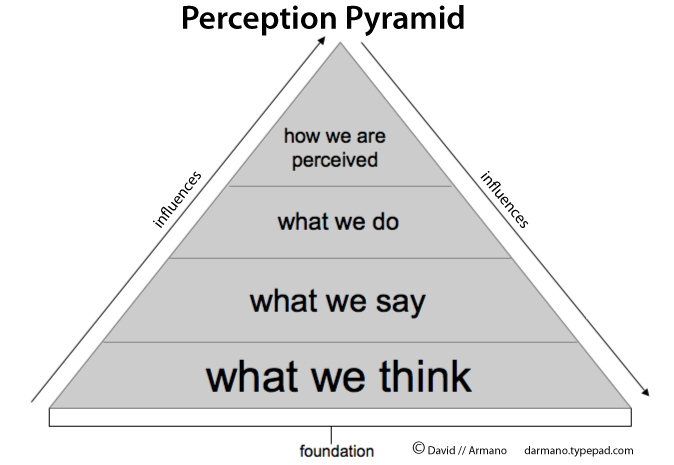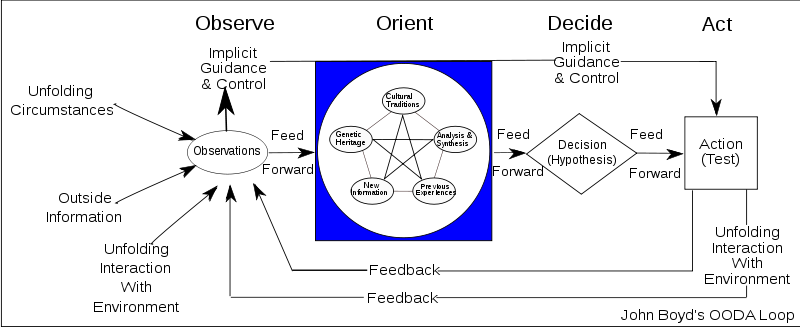Perception Pyramid vs. OODA Loop
Design guru David Armano had a graphic up that was intriguing from a psychological point of view:
My instant impression on seeing Armano’s visual was a reminder from Western philosophy and Eastern religion:
“We are what we frequently do” – Aristotle
“What we think, we become” – Buddha
The second impression from the graphic was it’s simultaneous representation as both a feedback loop and a hierarchy. As a hierarchy, I’m not certain I would put “what we say” as a more fundamental tier than “what we do” as Armano did. Actions would appear to be less subjective as events occuring in time and space than words but words moreso than the perceptions of others which we can neither control nor reliably audit, yet they very much influence us, as Armano suggests.
Compare the flow of information/action in Armano’s pyramidical graphic with John Boyd’s OODA Loop:
Boyd’s conception is not hierarchical or sequential, though many people view OODA as a deliberative step by step process, running through it in such a manner instead would slow the cycle considerably. Armano’s consideration of the perceptions of others would be important to Boyd as “outside information” and “unfolding interaction with environment”. It would address the mental and moral levels of conflict and competition:
- Mental (against individuals and groups): surprise, deception, shock, and ambiguity
- Moral (against groups): menace, uncertainty and mistrust, resulting in disintegration of cohesion and the moral fragmentation of the opponent into many non-cooperative centers of gravity, which pumps up friction.
It would also measure our ability to attract support from or positively influence third parties or allies.
Interested in any thoughts the readership might have on the comparison or from any of my numerous co-authors….





November 7th, 2008 at 5:27 am
Mark, I agree with your intitial reaction to the pyramid: it is philosophical and not practical. To make the image more realistic, I would split the second level from the bottom so that What We Say and What We Do are on the same plane. After all, a longstanding problem with our public diplomacy / strategic communication is that we failed to realize that what we say and what we do are not the same and that there are consequences to that. Perceptions may be based on one or the other or both. Armano’s pyramid is philosophical but not practical.
November 8th, 2008 at 4:09 am
Hi Matt
.
Armano’s diagram is a good "raw" visual equivalent of a think piece ( the dude has a history of creating conceptually powerful diagrams) but it definitely needs a tinkering/tweaking process. Your suggestion would make the pyramid more cognitively congruent with OODA as well.
.
Question for you: I agree that the discrepancy/hypocrisy between what we say and what we do is a problem for us and corrosive to our credibility. How would the world react, in your view, to the same actions backed by a more forthright and accountable advocacy/defense compared to the status quo ?
November 8th, 2008 at 4:39 am
Mark, I believe we’d see a positive response if our actions and words were "more forthright and accountable". Funny thing about accountability: when you’re accountable for your actions you tend to consider the second and third order effects. Accountability to the people, both the local population and distant population, including our own, is central to the "minds and wills" / "hearts and minds" struggle. Building trust and credibility is essential to winning the struggle for minds and wills. You can’t build either without being accountable for your actions. The military is already moving in the right direction. From the counterinsurgency manual (FM 3-24) to the Operations manual (FM 3-0) to the latest Stabilization Operations manual (FM 3-07), Army is capturing the need to be accountable for our actions in doctrine. It’ll be nice when our foreign policy is based on the same. Public diplomacy, when it was ‘created’ twenty years before the term was coined, was always to have a seat at the national security table to inform on the informational consequences of policy options. This has not happened because former and current senior members of government discounted the realities of peoples that forms the basis of today’s conflicts that are set in a global information environment, as well as the global struggle from the end of World War II until the 1960’s / 1970’s.
November 8th, 2008 at 4:45 am
Good answer.
.
Received the Smith-Mundt Symposium email update notification BTW. Will post on that soon.